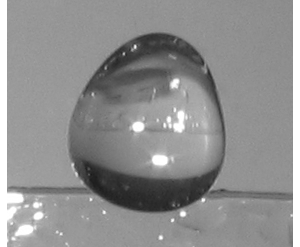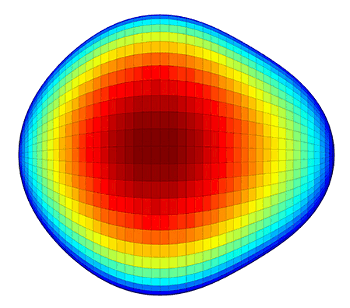Nuclear Pears
May 22, 2013
Liquid drops are typically illustrated as
tear drop shaped, a
sphere pointed at the top. That's just the shape when a drop first detaches from the
capillary trunk extending to the liquid source. After that, surface tension compacts the liquid into an ovoid.
 In the early twentieth century, the atomic nucleus seemed to have many things in common with a liquid drop. Nucleons in a nucleus seemed to act just as water molecules in a liquid, where the individual water molecules lose their identity and act as a collective fluid having properties such as uniform density and a surface tension.
The nuclear liquid drop model was first proposed by George Gamow
In the early twentieth century, the atomic nucleus seemed to have many things in common with a liquid drop. Nucleons in a nucleus seemed to act just as water molecules in a liquid, where the individual water molecules lose their identity and act as a collective fluid having properties such as uniform density and a surface tension.
The nuclear liquid drop model was first proposed by George Gamow, and then developed by
physics luminaries,
Niels Bohr and
John Archibald Wheeler.[1] It predicted quite a few nuclear properties accurately, particularly the
atomic masses using the
Bethe-Weizsäcker mass formula.
Just as
Newton's gravitational theory showed small problems that were only explained by
general relativity, it was found that the liquid drop model could not explain some nuclear properties, such as the
magic numbers of nucleons. I wrote about magic numbers in a
previous article (The Island of Stability, October 28, 2010).
Niel Bohr's son,
Aage Bohr, eliminated some of the problems of his father's liquid drop model, and he was awarded the 1975
Nobel Prize in Physics for his work. Since Niels Bohr won the 1922 prize, they joined the short list of father-son
physics laureates, which includes
Joseph John Thomson (1906) and his son,
George Paget Thomson (1937);
William Henry Bragg (1915) and his son,
William Lawrence Bragg (1915); and
Manne Siegbahn (1924) and his son,
Kai Siegbahn (1981).
 Almost indistinguishable in shape from an ovoid is the pear, which is somewhat like the fusion of two ovoids, one smaller than the other, with offset centroids. A huge international team with members from the United Kingdom, Germany, the United States, Switzerland, France, Belgium, Sweden, Finland, Poland and Spain, working at CERN, has created the short-lived isotopes of radon and radium, 220Rn and 224Ra, and have shown their nuclei are pear shaped.[2-9] Unlike the normal, quadrapole spherical/elliptical shape of other nuclei, these nuclei are octupole deformed.
In a pear-shaped nucleus, the asymmetric nuclear forces
Almost indistinguishable in shape from an ovoid is the pear, which is somewhat like the fusion of two ovoids, one smaller than the other, with offset centroids. A huge international team with members from the United Kingdom, Germany, the United States, Switzerland, France, Belgium, Sweden, Finland, Poland and Spain, working at CERN, has created the short-lived isotopes of radon and radium, 220Rn and 224Ra, and have shown their nuclei are pear shaped.[2-9] Unlike the normal, quadrapole spherical/elliptical shape of other nuclei, these nuclei are octupole deformed.
In a pear-shaped nucleus, the asymmetric nuclear forces push the
protons away from the center, so the ratio of the densities of
neutrons and protons are different as you move from one side of the nucleus to the other.[3-4] This result is important, since it might allow detection of a new nuclear force, one that explains the abundance of
matter over
antimatter in the
universe.[4]
If matter and antimatter were created in equal proportions at the
Big Bang, they would have
annihilated each other, so there's something in physics that explains why this didn't happen.[3-6] The
Standard Model, which has been verified in many
experiments, surprisingly has nothing to say about the matter-antimatter asymmetry.[3-4] The Standard Model combines gravitational,
electromagnetic, and the
weak and
strong nuclear forces.
One long-lived isotope of radium,
226Ra, was discovered to have a pear shaped nucleus in 1932, but other pear shaped nuclei need to be created artificially, and they have short
lifetimes.[6-7] The isotopes of radon and radium were produced at CERN by impact of protons on a
uranium carbide target and then accelerating the produced particles to 8% the
speed of light to impact targets of
nickel,
cadmium and
tin. This final impact excited the nuclei to higher
energy levels and produced
gamma rays that revealed the pear shape.[3-6,8]

The shape of 224Ra deduced from the CERN measurements.
220Rn does not have a fixed pear shape; instead, it oscillates around a pear shape.
(University of Liverpool Image by Liam Gaffney and Peter Butler.)
The CERN experiments, led by
University of Liverpool Professor of Physics,
Peter Butler, might unlock the secret of the matter/antimatter asymmetry by allowing a closer look at the
electric dipole moments in the nucleus.[4] The standard Model predicts a very small dipole moment, which is below experimental threshold for typical nuclei, but the dipole moment should be amplified in the pear shaped nuclei.[2,6,8,9] Some isotopes of
thorium and
uranium might have a more pronounced pear shape.[7]
This research may have already eliminated one nuclear model. The cluster model considers that a pear shape is similar to gluing
alpha particles onto a spherical nucleus. The model predicts that lighter isotopes should have a more pronounced pear shape than heavier ones, but the CERN experiments show the opposite to be true. The CERN results fit what's called the
mean field model more closely.[7]
References:
- George Gamow wrote several popular books about physics. In one of them, he described the difference between classical physics and quantum mechanics as being the difference between a lake and a chicken wire fence. Gamow was an author of the famous Alpher–Bethe–Gamow paper, for which he added Hans Bethe as an author just for artistic effect (i.e., having the Greek letters alpha-beta-gamma as authors). This didn't sit well for Alpher, who was Gamow's student at the time, since his fame was being diluted by not one, but two prominent physicists.
- L. P. Gaffney, P. A. Butler, M. Scheck A. B. Hayes, F. Wenander, M. Albers, B. Bastin, C. Bauer, A. Blazhev, S. Bönig, N. Bree, J. Cederkäll, T. Chupp, D. Cline, T. E. Cocolios, T. Davinson, H. De Witte, J. Diriken, T. Grahn, A. Herzan, M. Huyse, D. G. Jenkins, D. T. Joss, N. Kesteloot, J. Konki, et al., "Studies of pear-shaped nuclei using accelerated radioactive beams," Nature, vol. 497, no. 7448 (May 9, 2013), pp. 199-204.
- Exotic atoms hold clues to unsolved physics puzzle at the dawn of the universe, Phys.org, May 8, 2013.
- Nicole Casal Moore, "Exotic atoms hold clues to unsolved physics puzzle at the dawn of the universe,"University of Michigan Press Release, May 8, 2013.
- Richard Chirgwin, "Standard Model goes PEAR-SHAPED in CERN experiment," The Register (UK), May 9, 2013.
- Stephen Battersby, "Pear-shaped nucleus boosts search for new physics," Nature News, May 8, 2013.
- Peter Butler, "Scientists demonstrate pear shaped atomic nuclei," University of Liverpool Press Release, May 9, 2013.
- Smashing particles reveals predicted pear-shaped nuclei, Science Blog, May 9, 2013.
- Philippa Warr, "Study: Pear-shaped particle physics reveals matter/antimatter asymmetry," Wired (UK), May 9, 2013.
Permanent Link to this article
Linked Keywords: Liquid drop; tear drop; sphere; Wikimedia Commons; capillary action; capillary; surface tension; ovoid; twentieth century; atomic nucleus; nucleon; water molecule; fluid; density; George Gamow; physics; Niels Bohr; John Archibald Wheeler; atomic mass; semi-empirical mass formula; Bethe-Weizsäcker mass formula; Newton's law of universal gravitation; Newton's gravitational theory; general relativity; magic numbers of nucleons; Aage Bohr; Nobel Prize in Physics; physics laureate; J. J. Thomson; Joseph John Thomson; George Paget Thomson; William Henry Bragg; William Lawrence Bragg; Manne Siegbahn; Kai Siegbahn; red Bartlett pear; pear; centroid; United Kingdom; Germany; United States; Switzerland; France; Belgium; Sweden; Finland; Poland; Spain; CERN; isotope; radon; radium; pear shaped; nuclear force; proton; neutron; matter; antimatter; universe; Big Bang; annihilation; annihilated; Standard Model; experiment; electromagnetism; electromagnetic; weak interaction; strong interaction; strong nuclear force; isotopes of radium; 226Ra; half-life; lifetime; uranium carbide; speed of light; nickel; cadmium; tin; energy level; gamma ray; Liam Gaffney; Peter Butler; University of Liverpool; Professor of Physics; electric dipole moment; thorium; uranium; alpha particle; mean field model; Alpher–Bethe–Gamow paper.